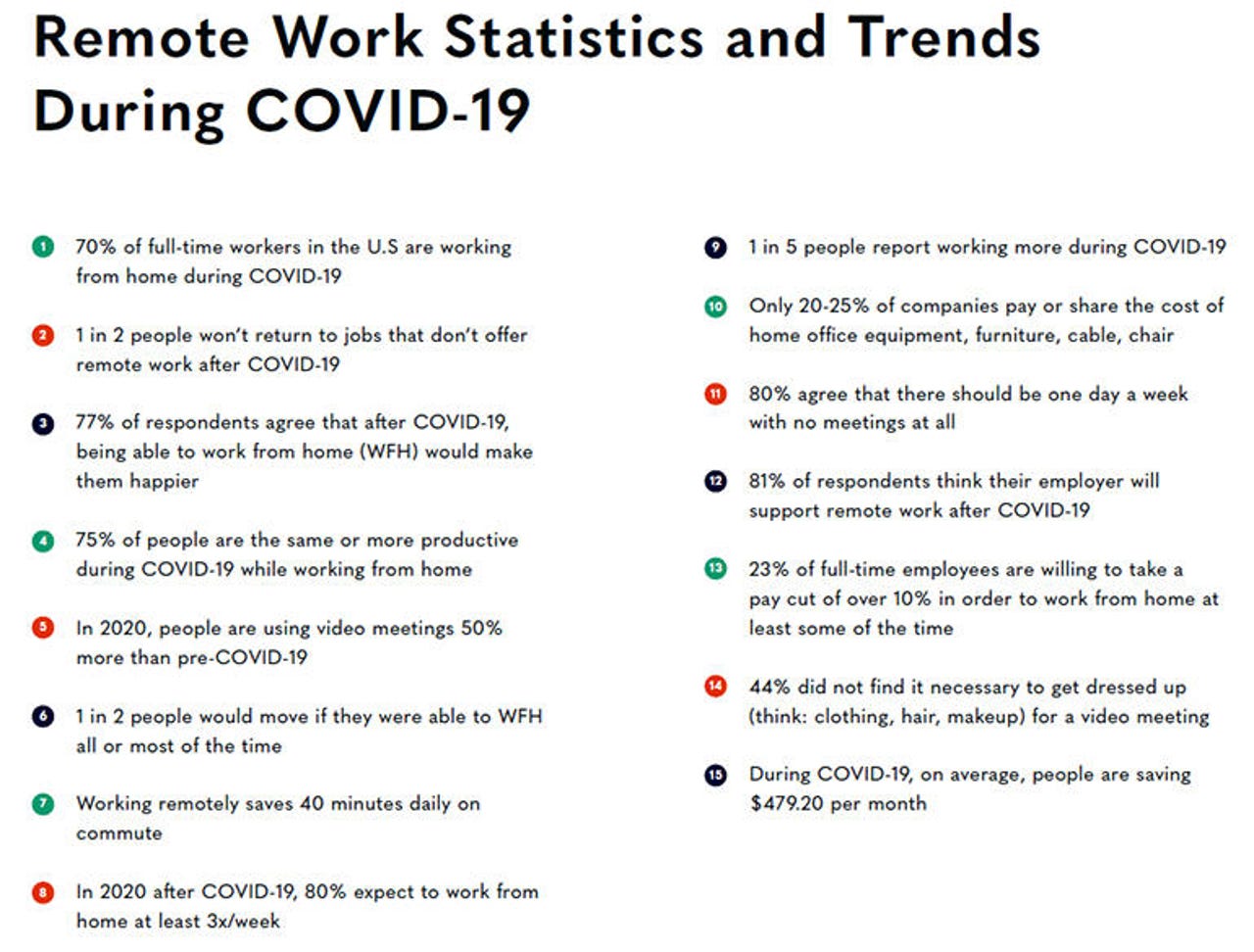Remote working, programming languages, artificial intelligence, and more: ZDNet's research roundup


WFH research: Managing a remote workforce
There's no doubt that remote working is here to stay. The next challenge is to manage it to the mutual benefit of workers and employers. These summary statistics from a survey by Owl Labs and Global Workspace Analytics give a good picture of the mid-pandemic situation.
For more see: Remote work: 10 ways to upgrade your working from home setup
Microsoft TypeScript leaps ahead of C#, PHP and C++ on GitHub
Microsoft's superset of JavaScript, TypeScript, has shot up to become the fourth most popular programming language on code collaboration platform GitHub. TypeScript's ascent is tracked in Microsoft-owned GitHub's 2020 State of the Octoverse report. The top three languages are JavaScript, followed by Python and Java.
For more see: Microsoft TypeScript leaps ahead of C#, PHP and C++ on GitHub
Automation will help shape digital transformation in 2021
Automation is top of mind to enable innovation. McKinsey estimates that automation could raise productivity in the global economy by up to 1.4% annually. The PwC Finance Effectiveness Benchmarking report, meanwhile, finds that up to 40% of time spent in the finance function can be reduced with automation and behavior change.
For more see: Top 8 trends shaping digital transformation in 2021
Technology to support a knowledge-based economy
Knowledge graphs can address key challenges such as data governance and data integration. Google embraced semantic technology, and coined the term Knowledge Graph in 2012. This marked the beginning of the meteoric rise of graph technology. Gartner has included knowledge graphs in its 2020 hype cycle for AI, at the peak of inflated expectations.
For more see: From data to knowledge and AI via graphs: Technology to support a knowledge-based economy
AI software market: Not as big as investors expect but still $37 billion by 2025
Researcher Forrester has defined four AI software segments. The largest segment will be AI maker platforms, which will grow to $13 billion by 2025. New AI-centric apps built on AI functions, such as medical diagnosis and risk-detection solutions, will be the second-largest, at almost $10 billion.
For more see: Sizing the AI software market: Not as big as investors expect but still $37 billion by 2025
Amnesia:33 vulnerabilities impact millions of smart and industrial devices
Security researchers disclosed 33 security flaws in four open-source TCP/IP libraries currently used inside the firmware of products from more than 150 vendors. Forescout researchers estimate that millions of consumer and industrial-grade devices are impacted by the security flaws they discovered, and which they named Amnesia:33.
For more see: Amnesia:33 vulnerabilities impact millions of smart and industrial devices
Head to head: Intel-based vs M1 Apple SOC-based MacBook Pro 13
Overall, the recently launched M1 MacBook Pro beats out the existing Intel line up. However, a few areas of improvement for future releases include the need for a better than 720p FaceTime camera (though the M1's ISP does improve the performance of the 1.2 megapixel camera), Wi-Fi 6 support, and the lack of a touchscreen.
For more see: Apple's 13-inch M1 MacBook Pro: An enterprise buyer's review
IBM buys cloud managed services provider Nordcloud
In late December, IBM said it will acquire Nordcloud, a Helsinki-based company that focuses on cloud integration in Europe. Nordcloud competes in a crowded cloud infrastructure managed services space. Here's where it fits in Gartner's Magic Quadrant.
For more see: IBM buys cloud managed services provider Nordcloud
Server revenue up slightly in Q3, according to IDC
Server revenue was up slightly in the third quarter as Arm-based servers and AMD CPUs drove growth along with China, according to IDC. The analyst reported that the global server revenue was up 2.2% from a year ago to $22.6 billion. Shipments declined 0.2% in the third quarter from a year ago.
For more see: Server revenue up slightly in Q3, but AMD, Arm systems surge, according to IDC
India's BoAt cracks top 5 in wearables in Q3, says IDC
India's BoAt wearable devices, wrist worn and hearables, have enabled it to crack the top 5 vendors in shipments for the third quarter, according to IDC data. BoAt is mostly known for its hearables, but those devices also track health and fitness. Overall, the global wearables market jumped 35.1% from a year ago to 125 million units.
For more see: India's BoAt cracks top 5 in wearables in Q3, says IDC